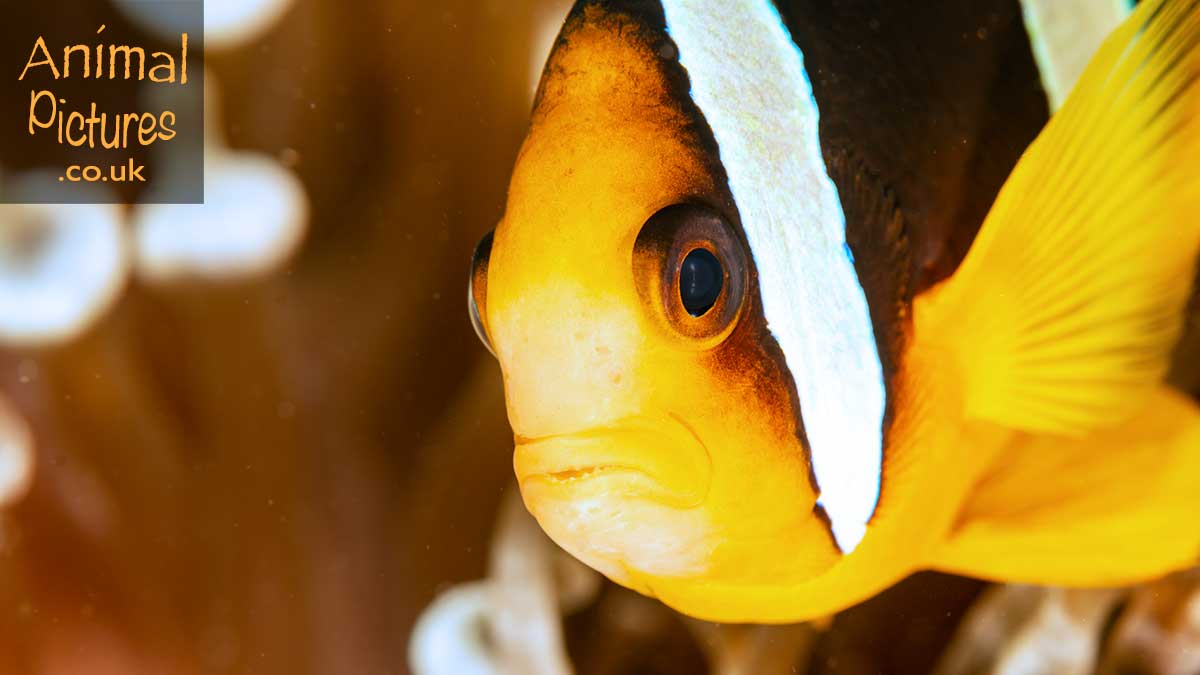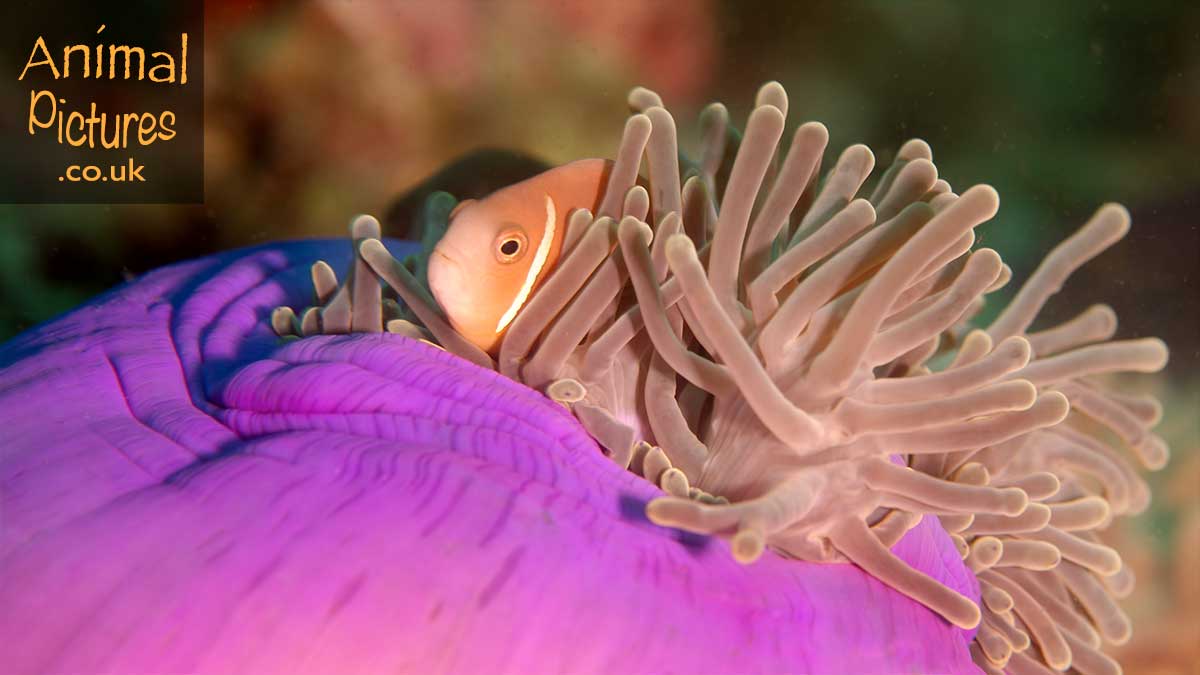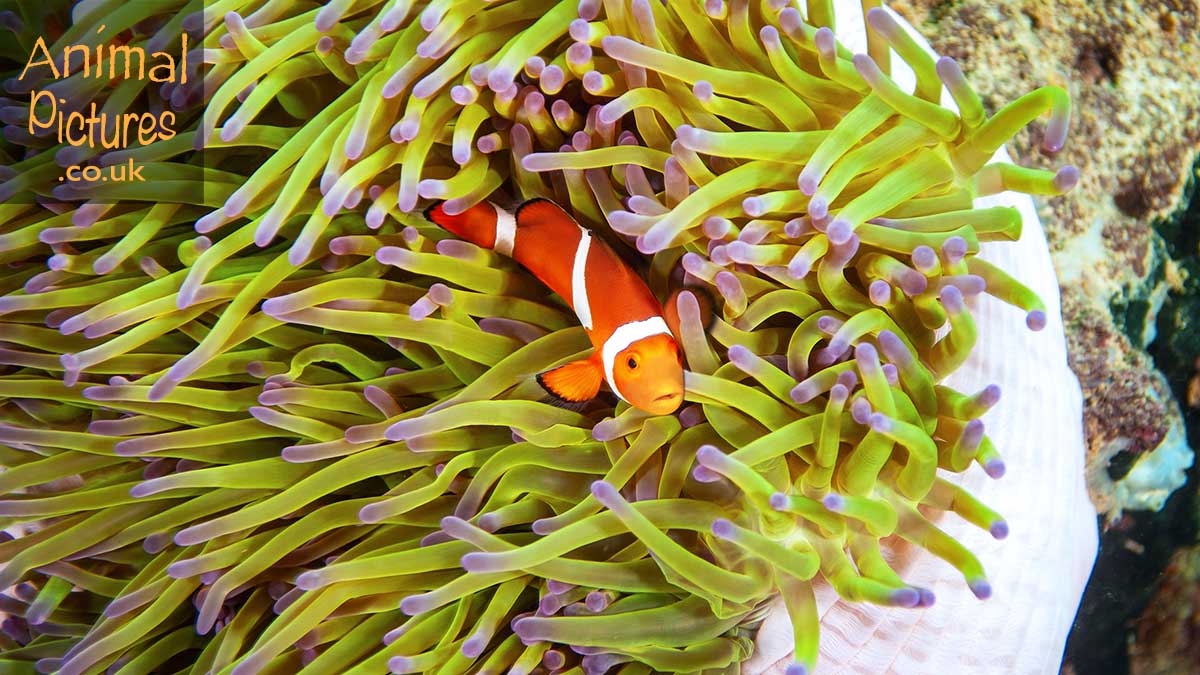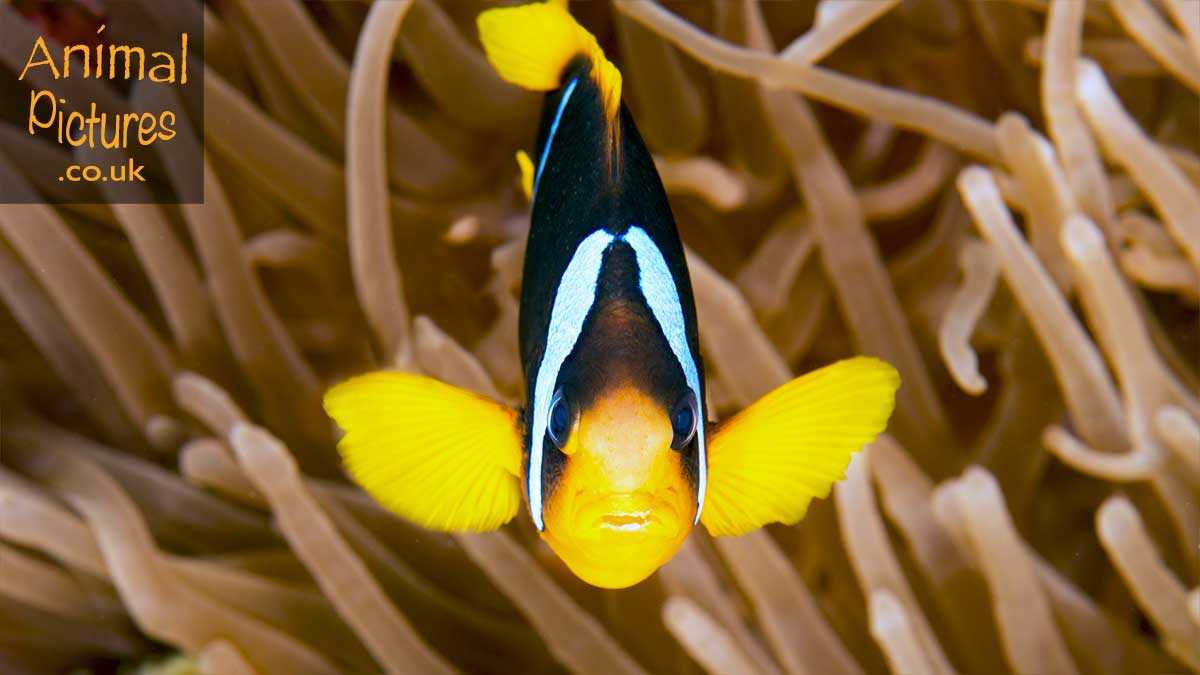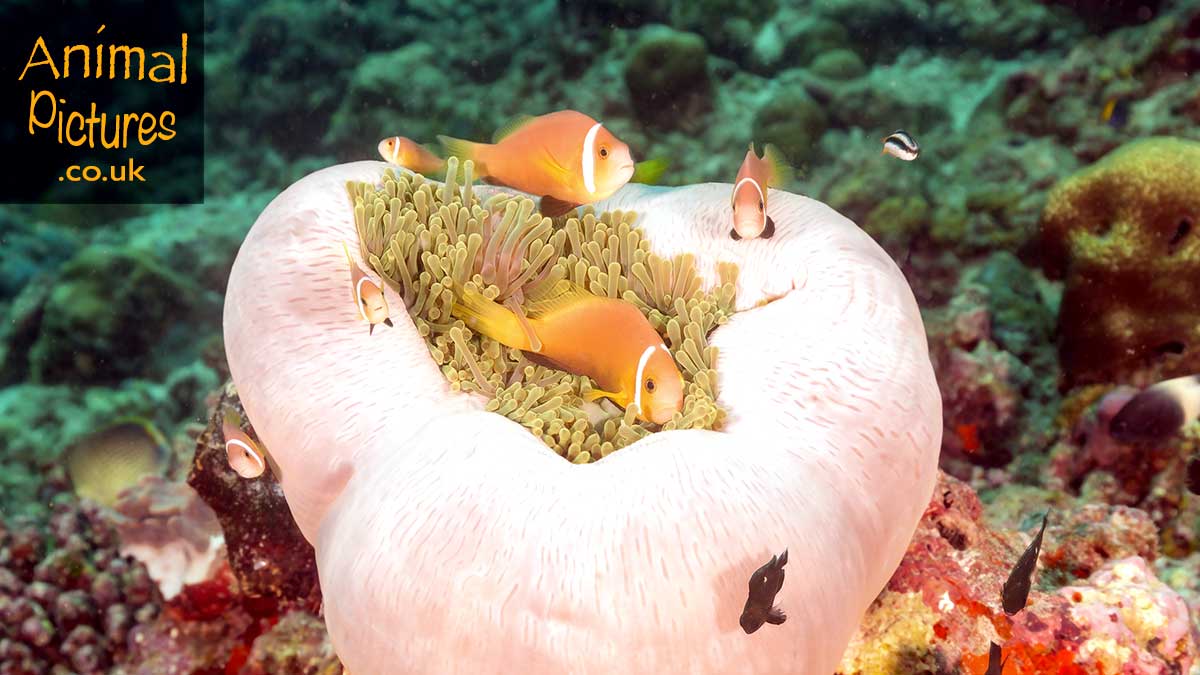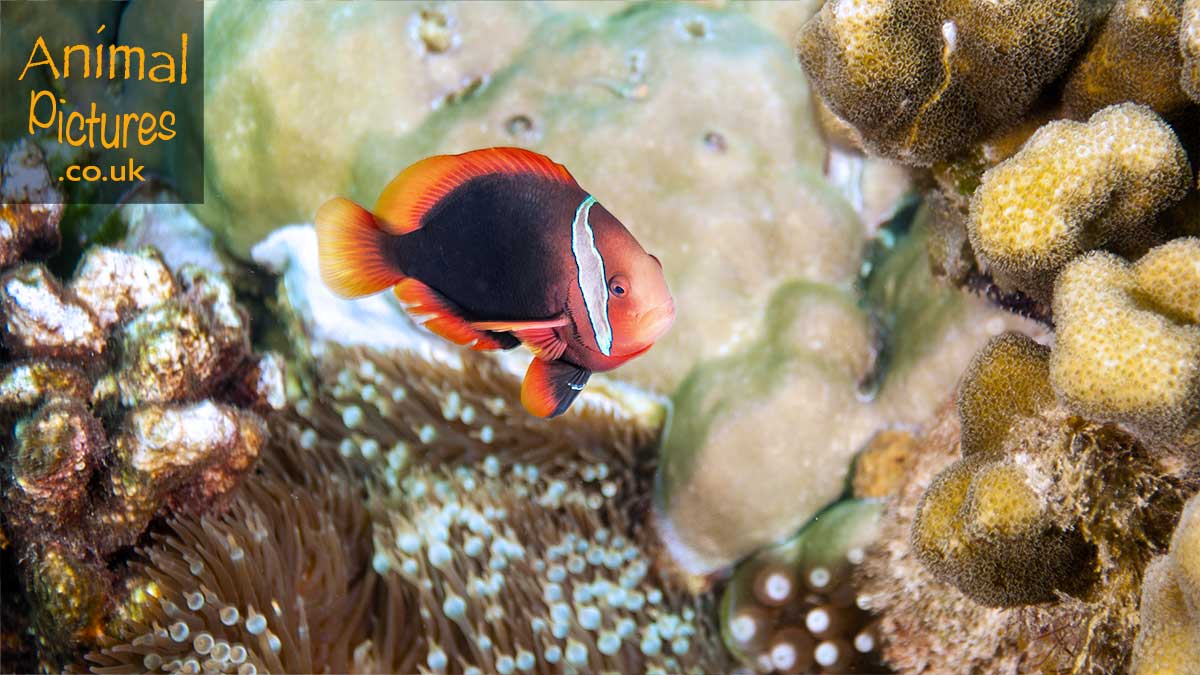Clownfish - famously cute
Underwater photography featuring clownfish pictures by Diana Davey & Bob Davey
What is a clownfish?
A journey through intricate coral reefs
Clownfish are diverse, with over 30 recognised species, each exhibiting unique colours and patterns. Enter the enchanting realm of clownfish and uncover a treasure trove of captivating facts that will leave you in awe! These vibrant marine creatures, famously known as the stars of Pixar's "Finding Nemo," boast a fascinating world waiting to be explored. From their unique symbiotic relationship with sea anemones to their remarkable ability to change gender, the clownfish never fails to surprise and amaze.
Colourful fish in underwater homes
Unravel the secrets behind their striking hues and unrivalled resilience in the vast ocean. These variations in species highlight the adaptability of clownfish to different marine environments and their successful evolution within the diverse ecosystems of the oceans. Enjoy our animal pictures featuring underwater photography of clownfish as elve into the unparalleled charm and wonder of clownfish. Immerse in a kaleidoscope of colours and discoveries as we dive into the mesmerising universe of clownfish!
Maldives Clownfish nestled amongst a sea anemone. Maldives Clownfish are a rusty orange colour with a single white stripe behind their eyes and a black fin. They are able to hide in groups within sea anemones as Clownfish are protected from the sting that anemones use to protect themselves.
Maldives Clownfish Facts
Other Name(s): Blackfinned anemonefish (clownfish), Maldive anemonefish (clownfish)
Scientific Name: Amphiprion nigripes
Family: Pomacentridae (Damselfishes)
Size: 11 cm
Diet: Omnivourous, zoplankton, small benthic crustaceans, algae
Habitat: Outer reef slopes, reef crests
Depth: 2 - 25 metres
Distribution: Indian Ocean; Maldives and Sri Lanka
Where do clownfish live?
Colourful underwater world
Clownfish, belonging to the subfamily Amphiprioninae, thrive primarily in the warm, shallow waters of the Pacific and Indian Oceans. Their habitat is predominantly found within coral reefs, where the complex structures provide both shelter and abundant food sources. The vibrant ecosystems of coral reefs offer clownfish a safe haven from predators, allowing them to flourish in this colourful underwater world. They are found at depths ranging from 1 to 30 meters, where they can easily navigate through the anemones that serve as their homes. The geographic distribution of clownfish is quite extensive. Most frequently associated with the Great Barrier Reef in Australia, the Red Sea, and the waters surrounding the islands of Indonesia and the Philippines, each specific region contributes to the diversity of clownfish species found there.
Variations and adaptations
With variations in colouration and size that reflect their adaptation to local environmental conditions. The warm temperatures and nutrient-rich waters of these areas make them ideal for clownfish, supporting not only their survival but also their reproduction and social behaviours. Interestingly, clownfish have a unique ability to thrive in a variety of marine environments. While they are most commonly linked to coral reefs, they can also be found in lagoons and protected areas where sea anemones grow. These adaptable fish have developed a symbiotic relationship with their anemone hosts, which allows them to occupy a niche that few other fish can. This relationship not only enhances their habitat options but also provides essential protection and resources that contribute to their overall success in the marine ecosystem.
Standing guard over his bubble-tip anemone home, surrounded by a selection of marine life including sea urchins, mushrooms corals and fire corals, creating a rainbow of colours. Maroon clownfish are notable for their deep maroon colour and bold white stripes, demonstrating the striking differences in colouration and size of the species.
Maroon Clownfish Facts
Other Name(s): Spinecheek Anemonefish, Spinecheek Clownfish
Scientific Name: Premnas biaculeatus
Family: Pomacentridae (Damselfishes)
Size: 17cm (female) 8 cm (male)
Diet: Zooplankton, benthic algae
Habitat: Coral and rocky coastal reefs, lagoons
Depth: 1 - 16 metres
Distribution: Indo-west pacific, Indonesia to Taiwan and the Great Barrier Reef<
What are the unique physical characteristics of clownfish?
Eye-catching colours
Clownfish are easily recognisable due to their vibrant colours and distinctive patterns. The most common colouration includes bright orange bodies adorned with white bands outlined in black, creating a striking appearance. These bold colours serve a dual purpose: they help the clownfish stand out against the backdrop of their coral reef homes, whilst providing camouflage among the anemones where they reside. Some species exhibit variations in hue, ranging from deep red to bright yellow. In addition to their eye-catching colours, clownfish possess several unique physical traits that enhance their survival. They have a laterally compressed body shape, which allows for agile movements through the complex structures of coral and anemones. Their pectoral fins are particularly well-developed, enabling them to manoeuvre efficiently in tight spaces.
Evolution and symbiosis
Clownfish also have a distinctive set of spines in their dorsal fin, which they can raise for defence against predators. This combination of agility and protective features makes them well-suited for their environment. Another fascinating aspect of clownfish anatomy is their ability to produce a mucous coating on their skin, which protects them from the stinging tentacles of their anemone hosts. This adaptation is crucial for their survival, as it allows them to coexist with anemones without suffering harm. The mucous layer not only provides a physical barrier but also plays a role in chemical signalling, helping to reinforce the bond between clownfish and their anemone. This remarkable adaptation highlights the intricate relationships within marine ecosystems and the evolutionary strategies that allow species to thrive in challenging environments.
Among the most well-known is the Ocellaris clownfish (Amphiprion ocellaris), often referred to as the "false clownfish." This species gained fame as the character Nemo in Pixar's "Finding Nemo." Ocellaris clownfish are easily recognisable due to their bright orange colour with white bands outlined in black.
Ocellaris Clownfish Facts
Other Name(s): Common Clownfish, False Percula Clownfish
Scientific Name: Amphiprion ocellaris
Family: Pomacentridae (Damselfishes)
Size: 11 cm
Diet: Zooplankton, benthic crustaceans, algae
Habitat: Coral reefs, outer reefs, shallow lagoons
Depth: 1 - 15 metres
Distribution: Indo-West Pacific; Eastern Indian Ocean to Southeast Asia, Indonesia, Philippines, northwest Australia, north to Taiwan
Clark's anemonefish prefer to live within sea anemones. There are several varieties of anemones that they prefer to occupy, although when they are unable to find a suitable home they will stay close to rock work. When they do find a home, they defend it diligently from any invaders or predators.
Chocolate Clownfish Facts
Common Name(s): Clark's anemonefish, yellowtail clownfish, chocolate clownfish
Scientific Name: Amphiprion clarkii
Family: Pomacentridae (Damselfishes)
Size: 15 cm
Diet: Omnivourous, zoplankton, algae
Habitat: Outer reef slopes, lagoons
Depth: 1 - 60 metres
Distribution: Indo-West Pacific: Persian Gulf to Western Australia, throughout the Indo-Australian Archipelago and in the western Pacific at the islands of Melanesia and Micronesia, north to Taiwan, southern Japan and the Ryukyu Islands.
Why is Clownfish behaviour and social structure fascinating?
Hierarchical social system
Clownfish exhibit fascinating behaviours that reflect their complex social structures. They are known for their hierarchical systems, particularly in the context of their relationships with anemones. A typical clownfish group consists of a dominant breeding pair, often referred to as the "female" and "male," along with several smaller, non-breeding individuals. The breeding female is the largest and most dominant member of the group, while the male is slightly smaller. This social structure is characterised by a clear pecking order, which is crucial for maintaining harmony. The behaviour of clownfish is highly interactive, communicating through a series of body movements and vocalisations. They engage in a ritualistic dance, often involving a series of quick movements and changes in position, which reinforce their social bonds and establish dominance within the group.
Protecting their survival
This behaviour is particularly evident during mating rituals, where the pair will perform synchronised movements to strengthen their partnership. Such interactions highlight the complexity of their social lives and the importance of cooperation in their survival. In addition to their social interactions, clownfish are also known for their territorial behaviour. They establish and defend their territory around their host anemone, chasing away intruders and rival fish that threaten their space. This territoriality is vital for their survival, as it ensures access to food resources and protection from predators. Clownfish are particularly aggressive when defending their anemones, demonstrating a fierce loyalty to their homes. This combination of social structure, communication, and territorial behaviour contributes to the dynamic lives of clownfish in their vibrant underwater ecosystems.
Clownfish family
Maldives clownfish (black-finned anemonefish) residing in the fluorescent tentacles of an anemone
Why are clownfish also known as 'anemonefish'?
Symbiotic interdependance
The relationship between clownfish and sea anemones is a remarkable examples of symbiosis in the marine world. Clownfish are known as "anemonefish" due to their close association with these stinging creatures. The mutualistic relationship benefits both species: clownfish receive protection from predators while the anemones gain nutrients from the waste produced by the clownfish. One of the intriguing aspects of this interdependence is the clownfish's ability to live among the anemone's stinging tentacles without being harmed. This is made possible through a process known as "mucous acclimation." Before a clownfish can safely approach an anemone, it must build up a protective mucous layer on its skin which shields the clownfish from the anemone's stinging cells and allows it to communicate chemically with its host.
A healthy home
Once acclimated, the clownfish can freely navigate its anemone home, taking refuge from predators while also enjoying a consistent food supply. The relationship between clownfish and sea anemones is not just about protection; it also involves behaviours that enhance the well-being of both species. Clownfish help to keep their anemone hosts clean by removing debris and parasites, which can improve the overall health of the anemone. Additionally, the clownfish's movements can stimulate the anemone’s tentacles, promoting growth and ensuring a healthy environment. This reciprocal relationship exemplifies the interconnectedness of marine life and showcases the vital role that clownfish play in maintaining the health of their anemone habitats.
Standing guard over its anemone home on a coral reef. Red Sea Anemonefish among the beautiful colours of the reef with the deep blue Red Sea behind. Anemonefish habitually reside within sea anemones located on patch reefs or sheltered bays. The relationship with sea anemones is mutually beneficial - anemonefish feed on small invertebrates, and defend the anemone from other fish such as butterflyfish which would otherwise harm the sea anemone. Red Sea anemonefish are a brightly coloured, lively fish that dart in and out of their anemone homes.
Red Sea Clownfish Facts
Other Name(s): Twoband Anemonefish
Scientific Name: Amphiprion bicinctus
Family: Pomacentridae (Damselfishes)
Size: 14 cm
Diet: Zooplankton, algae
Habitat: Coral Reefs; most reef habitats
Depth: 1 - 30 metres
Distribution: Gulf of Aden, Red Sea, Chagos Islands
What is the life cycle of a clownfish?
Courtship and parenting
Clownfish are known for their monogamous breeding pairs, which remain together for life. The breeding process typically begins with a courtship display, during which the male will perform a series of dances to attract the female's attention. Once a pair has formed, they will establish a territory around their anemone home, where they will lay their eggs. The female lays hundreds of eggs, usually on a flat surface close to their anemone, which the male then fertilises. After laying eggs, the male clownfish takes on the responsibility of guarding and caring for them. He actively aerates the eggs by fanning them with his fins, ensuring they receive adequate oxygen while also keeping them free from debris and potential predators. Eggs typically hatch within six to ten days, depending on water temperature and conditions.
Independent life cycle
Once the larvae emerge, they are carried away by ocean currents, marking the beginning of their independent life cycle. The early life stages of clownfish are challenging, and many larvae do not survive. However, those that do undergo a remarkable transformation as they grow. After a period of drifting in the open ocean, and as they begin to mature, they seek out the safety of anemones, where they will establish their territory and join a social group. This transition from free-swimming larvae to established residents of anemones is a critical phase in the life cycle of clownfish and highlights their unique adaptation to their environment. The combination of parental care, larval development, and eventual settlement in anemones underscores the complexity and resilience of clownfish reproduction.
Twoband anemonefish
Young Twoband Anemonefish hovering before a sea anemone, its fins spread as it gazes out from within the tentacles. Young twoband anemonefish are a beautiful soft yellow colour which darkens as they age.
Are there threats to clownfish populations?
The future for clownfish
Despite their vibrant presence in coral reefs, clownfish populations face several significant threats that jeopardise their survival. One of the most pressing challenges is habitat destruction, largely driven by human activities. Coral reef degradation due to climate change, pollution, and destructive fishing practices has led to the loss of crucial anemone habitats. As clownfish rely heavily on these ecosystems for shelter and food, the decline of coral reefs poses a direct threat to their populations. Additionally, the aquarium trade has a considerable impact on clownfish populations. While clownfish are popular in home aquariums due to their vibrant colours and engaging behaviours, the demand for wild-caught specimens often leads to overfishing.
Unsustainable collection methods can deplete local populations, affecting both the clownfish and the broader marine ecosystem. As more individuals are removed from their natural habitats, the delicate balance of the reef community is disrupted, culminating in a decline in clownfish numbers. Climate change also poses a significant threat to clownfish and their habitats. Rising ocean temperatures contribute to coral bleaching, a phenomenon where corals expel the algae living within them, leading to the loss of vibrant coral reefs. Increased ocean acidity further impacts coral growth and health, making it increasingly difficult for clownfish to find suitable anemone homes. As environmental conditions change, clownfish face an uncertain future, highlighting the urgent need for conservation efforts to protect these beloved marine creatures and their habitats.
Conservation efforts for clownfish
In light of the numerous threats faced by clownfish populations, various conservation efforts are underway to protect these remarkable species and their habitats. One of the primary strategies involves the establishment of marine protected areas (MPAs), which aim to conserve critical ecosystems and provide safe havens for marine life. By restricting fishing and other harmful activities within designated zones, MPAs help to preserve the delicate balance of coral reefs and ensure the survival of clownfish and their anemone partners. Another important aspect of clownfish conservation is the promotion of sustainable aquarium practices. Organisations and aquarists are increasingly advocating for captive-breeding programs that reduce the reliance on wild-caught specimens.
By breeding clownfish in controlled environments, it is possible to meet the demand for these colourful fish while minimising the impact on natural populations. This approach not only helps to conserve wild clownfish but also provides an opportunity for education about marine ecosystems and the importance of sustainable practices. Public awareness campaigns also play a critical role in conservation efforts. By educating people about the threats facing clownfish and the significance of their ecological roles, it is possible to foster a greater appreciation for these creatures. Initiatives that promote responsible tourism, sustainable fishing practices, and coral reef restoration contribute to the overall health of marine environments. Through collaboration between scientists, conservation organisations, and local communities, the future of clownfish can be safeguarded, ensuring that these vibrant fish continue to thrive in our oceans for generations to come.
Tomato Clownfish hovering over a bubble-tip anemone amongst the corals.Tomato clownfish take their common name from their appearance, featuring a bright orange body with a single white stripe.
Tomato Clownfish Facts
Other Name(s): Bridled Clownfish, Red Clownfish, Tomato Anemonefish
Scientific Name: Amphiprion frenatus
Family: Pomacentridae (Damselfishes)
Size: 14 cm
Diet: Omnivourous, red worms, brine shrimps, cyclops, daphnias, small crustaceans
Habitat: Sea anemones in coral reefs, lagoon reefs
Depth: 2 - 12 metres
Distribution: Western Pacific, South China Sea, Eastern Asia; Ryuku Islands to Malaysia and Indonesia
Why are clownfish important to the ecosystem?
Captivating clownfish
Clownfish are not only captivating due to their vibrant colours and unique behaviours but also play a vital role in the health of marine ecosystems. Through their symbiotic relationships with sea anemones, they contribute to the overall balance of coral reef communities, showcasing the interconnectedness of marine life. Understanding the complexity of clownfish, from their habitat and distribution to their reproductive strategies and conservation challenges, deepens our appreciation. The threats they face, including habitat destruction, overfishing, and climate change, require collective action and awareness.
The marine environment
By supporting conservation efforts, promoting sustainable practices, and fostering a deeper understanding of marine ecosystems, we can help ensure the survival of clownfish for future generations. Clownfish remind us of the beauty and wonder of the ocean. Their resilience, adaptability, and vibrant presence inspire us to cherish the rich biodiversity of our planet's waters. By celebrating these enchanting fish and advocating for their protection, we can contribute to the preservation of the colourful marine world they inhabit, ensuring that future generations have the opportunity to marvel at these aquatic treasures.
Amphiprion sebae family residing in Hadden's sea anemone atop a bejewelled coral reef. Sebae clownfish are relatively rare clownfishes, found only in the Indian Ocean. Their scientific name (Amphiprion sebae) comes from their perceived association with the sebae anemone, however they are normally found in saddle anemones (Hadden's sea anemone).
Sebae Clownfish Facts
Common Name(s): Sebae clownfish, brown clownfish
Scientific Name: Amphiprion sebae
Family: Damselfishes (Pomacentridae)
Max. size: 16 cm
Habitat: Saddle anemone (Stichodactyla haddoni) in coastal waters and lagoons
Depth: 2 - 25 metres
Distribution: Northern Indian Ocean: Arabian Peninsula, India, Sri Lanka, Maldives, Andaman Islands, and Sumatra and Java in Indonesia.
© All images in this article are copyright Animal Pictures, a brand name of Anim8design Ltd.

